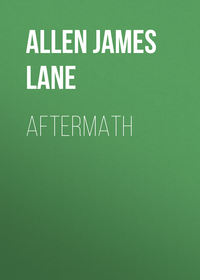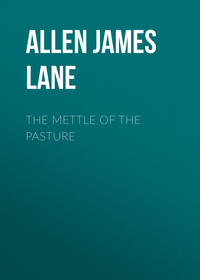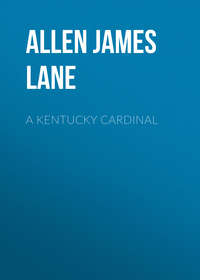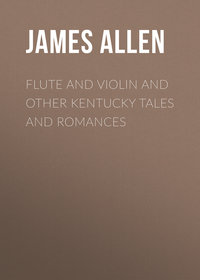 полная версия
полная версияThe Blue-Grass Region of Kentucky, and Other Kentucky Articles

James Lane Allen
The Blue-Grass Region of Kentucky, and Other Kentucky Articles
PREFACE
The articles herein reprinted from Harper's and The Century magazines represent work done at intervals during the period that the author was writing the tales already published under the title of Flute and Violin.
It was his plan that with each descriptive article should go a short story dealing with the same subject, and this plan was in part wrought out. Thus, with the article entitled "Uncle Tom at Home" goes the tale entitled "Two Gentlemen of Kentucky;" and with the article entitled "A Home of the Silent Brotherhood" goes the tale entitled "The White Cowl." In the same way, there were to be short stories severally dealing with the other subjects embraced in this volume. But having in part wrought out this plan, the author has let it rest – not finally, perhaps, but because in the mean time he has found himself engaged with other themes.
THE BLUE-GRASS REGION
IOne might well name it Saxon grass, so much is it at home in Saxon England, so like the loveliest landscapes of green Saxon England has it made other landscapes on which dwell a kindred race in America, and so akin is it to the type of nature that is peculiarly Saxon: being a hardy, kindly, beautiful, nourishing stock; loving rich lands and apt to find out where they lie; uprooting inferior aborigines, but stoutly defending its new domain against all invaders; paying taxes well, with profits to boot; thriving best in temperate latitudes and checkered sunshine; benevolent to flocks and herds; and allying itself closely to the history of any people whose content lies in simple plenty and habitual peace – the perfect squire-and-yeoman type of grasses.
In the earliest spring nothing is sooner afield to contest possession of the land than the blue-grass. Its little green spear-points are the first to pierce the soft rich earth, and array themselves in countless companies over the rolling landscapes, while its roots reach out in every direction for securer foothold. So early does this take place, that a late hoar-frost will now and then mow all these bristling spear-points down. Sometimes a slow-falling sleet will incase each emerald blade in glittering silver; but the sun by-and-by melts the silver, leaving the blade unhurt. Or a light snow-fall will cover tufts of it over, making pavilions and colonnades with white roofs resting on green pillars. The roofs vanish anon, and the columns go on silently rising. But usually the final rigors of the season prove harmless to the blue-grass. One sees it most beautiful in the spring, just before the seed stalks have shot upward from the flowing tufts, and while the thin, smooth, polished blades, having risen to their greatest height, are beginning to bend, or break and fall over on themselves and their nether fellows from sheer luxuriance. The least observant eye is now constrained to note that blue-grass is the characteristic element of the Kentucky turf – the first element of beauty in the Kentucky landscape. Over the stretches of woodland pasture, over the meadows and the lawns, by the edges of turnpike and lane, in the fence corners – wherever its seed has been allowed to flourish – it spreads a verdure so soft in fold and fine in texture, so entrancing by its freshness and fertility, that it looks like a deep-lying, thick-matted emerald moss. One thinks of it, not as some heavy, velvet-like carpet spread over the earth, but as some light, seamless veil that has fallen delicately around it, and that might be blown away by a passing breeze.
After this you will not see the blue-grass so beautiful. The seed ripens in June. Already the slender seed stalks have sprung up above the uniform green level, bearing on their summits the fuzzy, plumy, purplish seed-vessels; and save the soft, feathery undulations of these as the wind sweeps over them, the beauty of the blue-grass is gone. Moreover, certain robust and persistent weeds and grasses have been growing apace, roughening and diversifying the sward, so that the vista is less charming. During July and August the blue-grass lies comparatively inactive, resting from fructification, and missing, as well, frequent showers to temper the sunshine. In seasons of severe drought it even dies quite away, leaving the surface of the earth as bare and brown as a winter landscape or arid plain. Where it has been closely grazed, one may, in walking over it, stir such a dust as one would raise on a highway; and the upturned, half-exposed rootlets seem entirely dead. But the moderated heats and the gentle rains that usually come with the passing of summer bring on a second vigorous growth, and in the course of several weeks the landscape is covered with a verdure rivalling the luxuriance of spring.
There is something incongruous in this marvellous autumnal rejuvenescence of the blue-grass. All nature appears content and resting. The grapes on the sunward slopes have received their final coloring of purple and gold; the heavy mast is beginning to drop in the forest, followed by the silent lapse of russet and crimson leaves; the knee-deep aftermath has paled its green in the waiting autumn fields; the plump children are stretching out their nut-stained hands towards the first happy fire-glow on chill, dark evenings; and the cricket has left the sere, dead garden for a winter home at the hearth. Then, lo! as if by some freakish return of the spring to the edge of winter the pastures are suddenly as fresh and green as those of May. The effect on one who has the true landscape passion is transporting and bewildering. Such contrasts of color it is given one to study nowhere but in blue-grass lands. It is as if the seasons were met to do some great piece of brocading. One sees a new meaning in Poe's melancholy thought – the leaves of the many-colored grass.
All winter the blue-grass continues green – it is always green, of course, never blue– and it even grows a little, except when the ground is frozen. Thus, year after year, drawing needful nourishment from the constantly disintegrating limestone below, flourishes here as nowhere else in the world this wonderful grass.
Even while shivering in the bleak winds of March, the young lambs frolicked away from the distent teats of the ewes, with growing relish for its hardy succulence, and by-and-by they were taken into market the sooner and the fatter for its developing qualities. During the long summer, foaming pails of milk and bowls of golden butter have testified to the Kentucky housewife with what delight the cows have ruminated on the stores gathered each plentiful day. The Kentucky farmer knows that the distant metropolitan beef-eater will in time have good reason to thank it for yonder winding herd of sleek young steers that are softly brushing their rounded sides with their long, white, silky tails, while they plunge their puffing noses into its depths and tear away huge mouthfuls of its inexhaustible richness. Thorough-bred sire and dam and foal in paddocks or deeper pastures have drawn from it form and quality and organization: hardness and solidity of bone, strength of tendon, firmness and elasticity of muscle, power of nerve, and capacity of lung. Even the Falstaff porkers, their eyes gleaming with gluttonous enjoyment, have looked to it for the shaping of their posthumous hams and the padding of their long backbones in depths of snowy lard. In winter mules and sheep and horses paw away the snow to get at the green shoots that lie covered over beneath the full, rank growth of autumn, or they find it attractive provender in their ricks. For all that live upon it, it is perennial and abundant, beautiful and beneficent – the first great natural factor in the prosperity of the Kentucky people. What wonder if the Kentuckian, like the Greek of old, should wish to have even his paradise well set in grass; or that, with a knowing humor, he should smile at David for saying, "He maketh his grass to grow upon the mountains," inasmuch as the only grass worth speaking of grows on his beloved plain!
IIBut if grass is the first element in the lovely Kentucky landscape, as it must be in every other one, by no means should it be thought sole or chief. In Dante, as Ruskin points out, whenever the country is to be beautiful, we come into open air and open meadows. Homer places the sirens in a meadow when they are to sing. Over the blue-grass, therefore, one walks into the open air and open meadows of the blue-grass land.
This has long had reputation for being one of the very beautiful spots of the earth, and it is worth while to consider those elements of natural scenery wherein the beauty consists.
One might say, first, that the landscape possesses what is so very rare even in beautiful landscapes – the quality of gracefulness. Nowhere does one encounter vertical lines or violent slopes; nor are there perfectly level stretches like those that make the green fields monotonous in the Dutch lowlands. The dark, finely sifted soil lies deep over the limestone hills, filling out their chasms to evenness, and rounding their jagged or precipitous edges, very much as a heavy snow at night will leave the morning landscape with mitigated ruggedness and softer curves. The long, slow action of water has further moulded everything into symmetry, so that the low ancient hills descend to the valleys in exquisite folds and uninterrupted slopes. The whole great plain undulates away league after league towards the distant horizon in an endless succession of gentle convex surfaces – like the easy swing of the sea – presenting a panorama of subdued swells and retiring surges. Everything in the blue-grass country is billowy and afloat. The spirit of nature is intermediate between violent energy and complete repose; and the effect of this mild activity is kept from monotony by the accidental perspective of position, creating variety of details.
One traces this quality of gracefulness in the labyrinthine courses of the restful streams, in the disposition of forest masses, in the free, unstudied succession of meadow, field, and lawn. Surely it is just this order of low hill scenery, just these buoyant undulations, that should be covered with the blue-grass. Had Hawthorne ever looked on this landscape when most beautiful, he could never have said of England that "no other country will ever have this charm of lovely verdure."
Characteristically beautiful spots on the blue-grass landscape are the woodland pastures. A Kentucky wheat field, a Kentucky meadow, a Kentucky lawn, is but a field, a meadow, a lawn, found elsewhere; but a Kentucky sylvan slope has a loveliness unique and local. Rightly do poets make pre-eminently beautiful countries abound in trees. John Burroughs, writing with enthusiasm of English woods, has said that "in midsummer the hair of our trees seems to stand on end; the woods have a frightened look, or as if they were just recovering from a debauch." This is not true of the Kentucky woods, unless it be in some season of protracted drought. The foliage of the Kentucky trees is not thin nor dishevelled, the leaves crowd thick to the very ends of the boughs, and spread themselves full to the sky, making, where they are close together, under-spaces of green gloom scarcely shot through by sunbeams. Indeed, one often finds here the perfection of tree forms. I mean that rare development which brings the extremities of the boughs to the very limit of the curve that nature intends the tree to define as the peculiar shape of its species. Any but the most favorable conditions leave the outline jagged, faulty, and untrue. Here and there over the blue-grass landscape one's eye rests on a cone-shaped, or dome-shaped, or inverted pear-shaped, or fan-shaped tree. Nor are fulness of leafage and perfection of form alone to be noted; pendency of boughs is another distinguishing feature. One who loves and closely studies trees will note here the comparative absence of woody stiffness. It is expected that the willow and the elm should droop their branches. Here the same characteristic strikes you in the wild cherry, the maple, and the sycamore – even in great walnuts and ashes and oaks; and I have occasionally discovered exceeding grace of form in hackberries (which usually look paralytic and as if waiting to hobble away on crutches), in locusts, and in the harsh hickories – loved by Thoreau.
But to return to the woodland pastures. They are the last vestiges of that unbroken primeval forest which, together with cane-brakes and pea-vines, covered the face of the country when it was first beheld by the pioneers. No blue-grass then. In these woods the timber has been so cut out that the remaining trees often stand clearly revealed in their entire form, their far-reaching boughs perhaps not even touching those of their nearest neighbor, or interlacing them with ineffectual fondness. There is something pathetic in the sight, and in the thought of those innumerable stricken ones that in years agone were dismembered for cord-wood and kitchen stoves and the vast fireplaces of old-time negro cabins. In the well kept blue-grass pasture undergrowth and weeds are annually cut down, so that the massive trunks are revealed from a distance; the better because the branches seldom are lower than from ten to twenty feet above the earth. Thus in its daily course the sun strikes every point beneath the broad branches, and nourishes the blue-grass up to the very roots. All savagery, all wildness, is taken out of these pastures; they are full of tenderness and repose – of the utmost delicacy and elegance. Over the graceful earth spreads the flowing green grass, uniform and universal. Above this stand the full, swelling trunks – warm browns and pale grays – often lichen-flecked or moss-enamelled. Over these expand the vast domes and canopies of leafage. And falling down upon these comes the placid sunshine through a sky of cerulean blueness, and past the snowy zones of gleaming cloud. The very individuality of the tree comes out as it never can in denser places. Always the most truly human object in still, voiceless nature, it here throws out its arms to you with imploring tenderness, with what Wordsworth called "the soft eye-music of slow-waving boughs." One cannot travel far in the blue-grass country without coming upon one of these woodland strips.
Of the artistic service rendered the landscape of this region by other elements of scenery – atmosphere and cloud and sky – much might, but little will, be said. The atmosphere is sometimes crystalline, sometimes full of that intense repose of dazzling light which one, without ever having seen them, knows to be on canvases of Turner. Then, again, it is amber-hued, or tinged with soft blue, graduated to purple shadows on the horizon. During the greater part of the year the cloud-sky is one of strongly outlined forms; the great white cumuli drift over, with every majesty of design and grace of grouping; but there come, in milder seasons, many days when one may see three cloud belts in the heavens at the same time, the lowest far, far away, and the highest brushing softly, as it were, past the very dome of the inviolable blue. You turn your eye downward to see the light wandering wistfully among the low distant hills, and the sweet tremulous shadows crossing the meadows with timid cadences. It is a beautiful country; the Kentucky skies are not the cold, hard, brilliant, hideous things that so many writers on nature style American skies (usually meaning New England skies), as contrasted with skies European. They are at times ineffably warm in tone and tender in hue, giving aerial distances magical and fathomless above, and throwing down upon the varied soft harmonious greens of the landscape below, upon its rich browns and weathered grays and whole scheme of terrene colors, a flood of radiance as bountiful and transfiguring as it is chastened and benign.
But why make a description of the blue-grass region of Kentucky? What one sees may be only what one feels – only intricate affinities between nature and self that were developed long ago, and have become too deep to be viewed as relations or illusions. What two human beings find the same things in the face of a third, or in nature's? Descriptions of scenery are notoriously disappointing to those whose taste in landscape is different, or who have little or no sentiment for pure landscape beauty. So one coming hither might be sorely disappointed. No mountains; no strips of distant blue gleaming water nor lawny cascades; no grandeur; no majesty; no wild picturesqueness. The chords of landscape harmony are very simple; nothing but softness and amenity, grace and repose, delicacy and elegance. One might fail at seasons to find even these. This is a beautiful country, but not always; there come days when the climate shows as ugly a temper as possible. Not a little of the finest timber has been lost by storms. The sky is for days one great blanket of grewsome gray. In winter you laugh with chattering teeth at those who call this "the South," the thermometer perhaps registering from twelve to fifteen degrees below zero. In summer the name is but a half-truth. Only by visiting this region during some lovely season, or by dwelling here from year to year, and seeing it in all the humors of storm and sunshine, can one love it.
IIIBut the ideal landscape of daily life must not be merely beautiful: it should be useful. With what may not the fertility of this region be compared? With the valleys of the Schuylkill, the Shenandoah, and the Genesee; with the richest lands of Lombardy and Belgium; with the most fertile districts of England. The evidences of this fertility are everywhere. Nature, even in those places where she has been forced for nearly a hundred years to bear much at the hands of a not always judicious agriculture, unceasingly struggles to cover herself with bushes of all sorts and nameless annual weeds and grasses. Even the blue-grass contends in vain for complete possession of its freehold. One is forced to note, even though without sentiment, the rich pageant of transitory wild bloom that will force a passage for itself over the landscape: firmaments of golden dandelions in the lawns; vast beds of violets, gray and blue, in dim glades; patches of flaunting sunflowers along the road-sides; purple thistles; and, of deeper purple still and far denser growth, beautiful ironweed in the woods; with many clumps of alder bloom, and fast-extending patches of perennial blackberry, and groups of delicate May-apples, and whole fields of dog-fennel and golden-rod. And why mention indomitable dock and gigantic poke, burrs and plenteous nightshade, and mullein and plantain, with dusty gray-green ragweed and thrifty fox-tail? – an innumerable company.
Maize, pumpkins, and beans grow together in a field – a triple crop. Nature perfects them all, yet must do more. Scarce have the ploughs left the furrows before there springs up a varied wild growth, and a fourth crop, morning-glories, festoon the tall tassels of the Indian corn ere the knife can be laid against the stalk. Harvest fields usually have their stubble well hidden by a rich, deep aftermath. Garden patches, for all that hoe and rake can do, commonly look at last like spots given over to weeds and grasses. Sidewalks quickly lose their borders. Pavements would soon disappear from sight; the winding of a distant stream through the fields can be readily followed by the line of vegetation that rushes there to fight for life, from the minutest creeping vines to forest trees. Every neglected fence corner becomes an area for a fresh colony. Leave one of these sweet, humanized woodland pastures alone for a short period of years, it runs wild with a dense young natural forest; vines shoot up to the tops of the tallest trees, and then tumble over in green sprays on the heads of others.
A kind, true, patient, self-helpful soil if ever there was one! Some of these lands after being cultivated, not always scientifically, but always without artificial fertilizers, for more than three-quarters of a century, are now, if properly treated, equal in productiveness to the best farming lands of England. The farmer from one of these old fields will take two different crops in a season. He gets two cuttings of clover from a meadow, and has rich grazing left. A few counties have at a time produced three-fourths of the entire hemp product of the United States. The State itself has at different times stood first in wheat and hemp and Indian corn and wool and tobacco and flax, although half its territory is covered with virgin forests. When lands under improper treatment have become impoverished, their productiveness has been restored, not by artificial fertilizers, but by simple rotation of crops, with nature's help. The soil rests on decomposable limestone, which annually gives up to it in solution all the essential mineral plant food that judicious agriculture needs.
Soil and air and climate – the entire aggregate of influences happily co-operative – make the finest grazing. The Kentucky horse has carried the reputation of the country into regions where even the people could never have made it known. Your expert in the breeding of thoroughbreds will tell you that the muscular fibre of the blue-grass animal is to that of the Pennsylvania-bred horses as silk to cotton, and the texture of his bone, compared with the latter's, as ivory beside pumice-stone. If taken to the Eastern States, in twelve generations he is no longer the same breed of horse. His blood fertilizes American stock the continent over. Jersey cattle brought here increase in size. Sires come to Kentucky to make themselves and their offspring famous.
The people themselves are a fecund race. Out of this State have gone more to enrich the citizenship of the nation than all the other States together have been able to send into it. So at least your loyal-hearted Kentuckian looks at the rather delicate subject of inter-State migration. By actual measurement the Kentucky volunteers during the Civil War were found to surpass all others (except Tennesseeans) in height and weight, whether coming from the United States or various countries of Europe. But for the great-headed Scandinavians, they would have been first, also, in circumference around the forehead and occiput. Still, Kentucky has little or no literature.
One element that should be conspicuous in fertile countries does not strike the observer here – much beautiful water; no other State has a frontage of navigable rivers equal to that of Kentucky. But there are few limpid, lovely, smaller streams. Wonderful springs there are, and vast stores of water in the cavernous earth below; but the landscape lacks the charm of this element – clear, rushing, musical, abundant. The watercourses, ever winding and graceful, are apt to be either swollen and turbid or insignificant; of late years the beds seem less full also – a change consequent, perhaps, upon the denudation of forest lands. In a dry season the historic Elkhorn seems little more than a ganglion of precarious pools.
IVThe best artists who have painted cultivated ground have always been very careful to limit the area of the crops. Undoubtedly the substitution of a more scientific agriculture for the loose and easy ways of primitive husbandry has changed the key-note of rural existence from a tender Virgilian sentiment to a coarser strain, and as life becomes more unsophisticated it grows less picturesque. When the work of the old-time reaper is done by a fat man with a flaming face, sitting on a cast-iron machine, and smoking a cob pipe, the artist will leave the fields. Figures have a terrible power to destroy sentiment in pure landscape; so have houses. When one leaves nature, pure and simple, in the blue-grass country, he must accordingly pick his way circumspectly or go amiss in his search for the beautiful. If his taste lead him to desire in landscapes the finest evidences of human labor, the high artificial finish of a minutely careful civilization, he will here find great disappointment. On the other hand, if he delight in those exquisite rural spots of the Old World with picturesque bits of homestead architecture and the perfection of horticultural and unobtrusive botanical details, he will be no less aggrieved. What he sees here is neither the most scientific farming, simply economic and utilitarian – raw and rude – nor that cultivated desire for the elements in nature to be so moulded by the hand of man that they will fuse harmoniously and inextricably with his habitations and his work.









